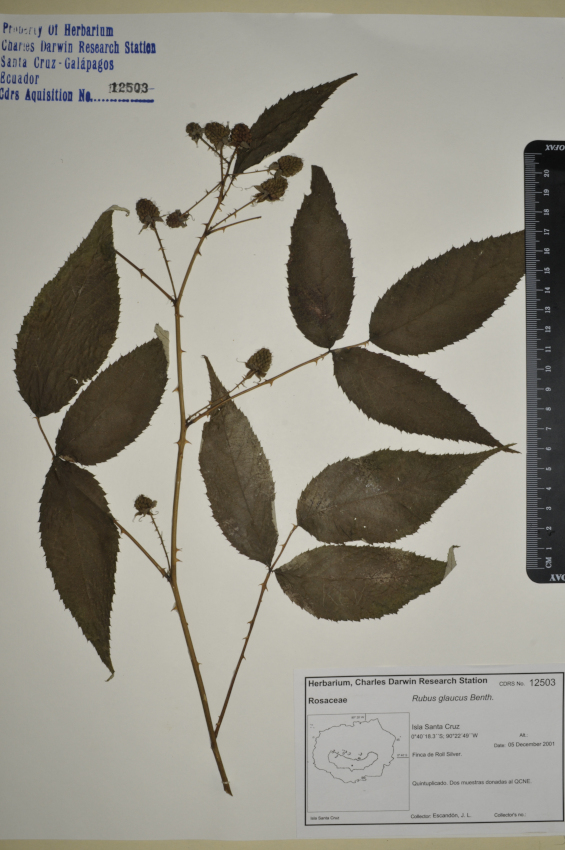Galapagos Species Database
The Galapagos Species Database shares the information about the species from our Natural History Collections.
Rubus glaucus
mora de Castilla, mora Andina, mora blanca, andean raspberry, Andes berry



A type of blackberry that is a natural hybrid, grown for its large and purple fruit. The leaves are composed of three leaflets.
A type of blackberry that is a natural hybrid, grown for its large and purple fruit. The leaves are composed of three leaflets.
Domain
Eukaryota
Kingdom
Plantae
Phylum
Magnoliophyta
Class
Magnoliopsida (= Dicotyledoneae)
Order
Rosales
Family
Rosaceae
Genus
Rubus
Species
glaucus
Taxon category: Accepted
Syn.: Rubus eriocarpus Liebm.
Origin: Introduced - established
Year of first record: 2000
Year of introduction: 1968
Mode of introduction: Intentional
Introduction Pathway: Intentional
Subpathway: Agriculture/Horticulture
Introduced status: Naturalized
Invasive status: Invasive
Impact in Galapagos: Still scarce in the Galapagos, currently has no known impact.
Impact elsewhere: The species is present in many Pacific islands and is considered a potentially invasive species affecting native forests, and bracken and prairie areas.
Control History in Galapagos: There was a thorough monitoring and control program from 2002-2006. The distribution of the plant suggests that the produced fruits are dispersed by birds. Although their eradication is feasible, control and monitoring has been needed annually since 2006.
Control methods elsewhere: The seedlings should be pulled manually. Herbicide should be applied to juveniles and adults.
Preference for an altitude zone in Galapagos: Humid zone
Trophic role: Primary producer
Growth form: Shrubs
Distribution origin: Northwestern South America, Central America
Map of specimen collection localities or observation records for this species in our collections database.
Distribution: Santa Cruz: 8 sites on farms in El Carmen and the National Park (estimated total area of 38 ha), originally from North and South America.
- Tropicos.org. (2017) Database of Missouri Botanical Garden. Tropicos.org. Missouri Botanical Garden. 06 Oct 2017 <http://www.tropicos.org
- Stevens, W.D. Ulloa, C., Pool, A., & Montiel, O.M. (2001) Flora de Nicaragua. Monogr. Syst. Bot. Missouri Bot. Gard. 85: i–xlii, 1–2666.
- Pankhurst, R.J. (2001) Rosaceae. En: Stevens, W.D., C. Ulloa, A. Pool & O.M. Montiel (eds.). Flora de Nicaragua. Monogr. Syst. Bot. Missouri Bot. Gard. 85: 2202–2206.
- Jaramillo, P. Bassantes, J. & Tye, A. (2005) Viability of seeds in food products proposed for field trips in Galapagos. Noticias de Galápagos 63: 16-18.
- Guézou, A. Trueman, M., Buddenhagen, E., Chamorro, S., Guerrero, A.M., Pozo, P., Atkinson, R. (2010) An extensive Alien Plan Inventory from the Inhabited Areas of Galapagos Plos One/ www.plosone.org. Volume 5/ Issue 4/e10276
- Jaramillo, P. Bassantes, J. & Tye, A. (2005) Viability of seeds in food products proposed for field trips in Galapagos. Noticias de Galápagos 63: 16-18.
- Tye, A. M. C. Soria and M. R. Gardener (2002) A strategy for Galapagos weeds. In Veitch, C. R. and Clout, M. N. (eds.) Turning the tide: the eradication of native species. IUCN SSC Invasive Species Specialist Group. IUCN, Gland, Switzerland and Cambridge, UK. IUCN SSC Invasive Species Specialist Group. IUCN, Gland, Switzerland and Cambridge, UK.
You are welcome to download and use the information found in this page, acknowledging its source.
This page should be cited as follows:
"Galapagos Species Database, Rubus glaucus", dataZone. Charles Darwin Foundation, https://datazone.darwinfoundation.org/en/checklist/?species=1667. Accessed 27 April 2025.


Dispersal propagule: Fruit
Seeds are dispersed via ingestion by animals, especially birds.